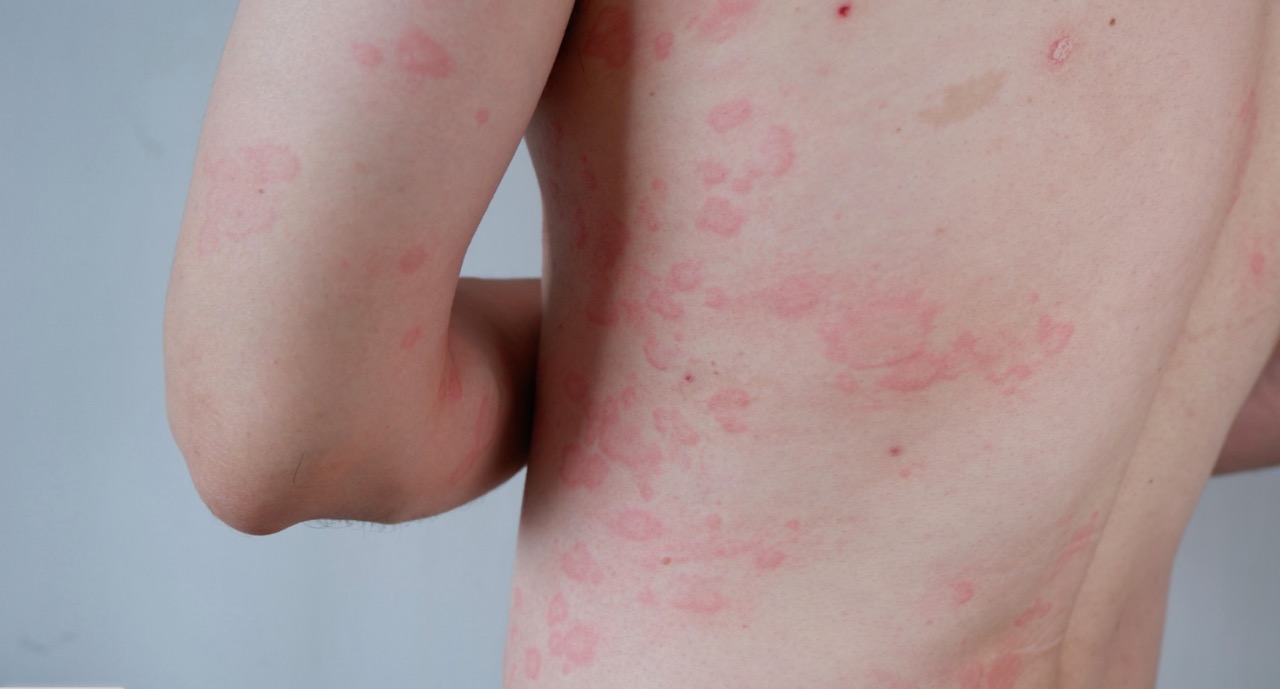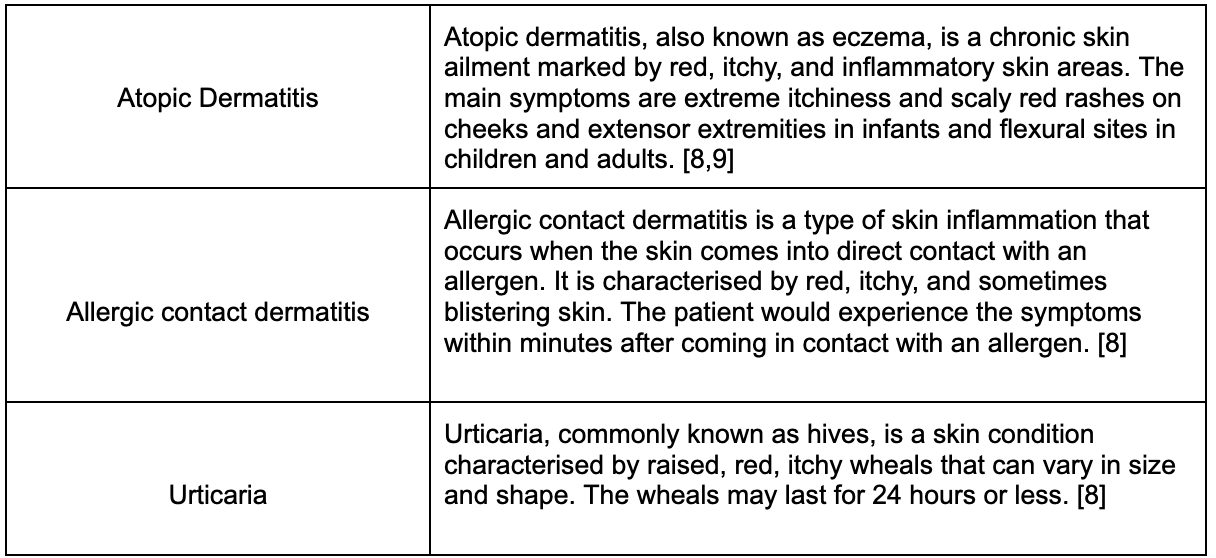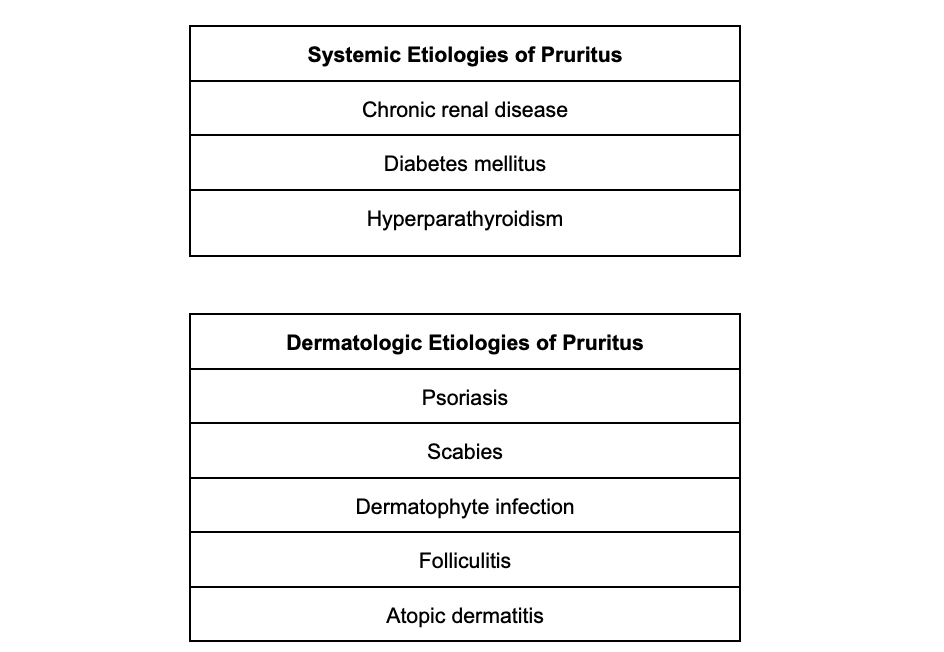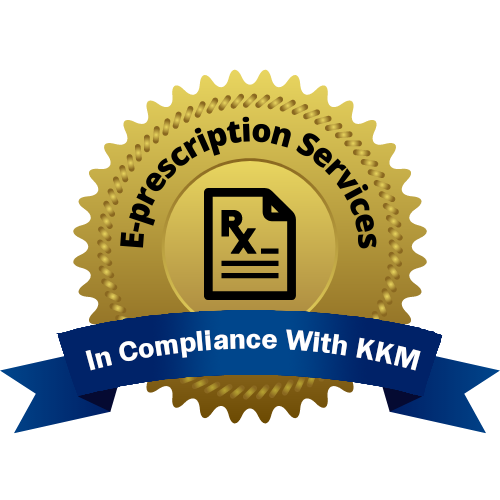Understanding allergic pruritus
Allergic pruritus, characterized by intense itching, arises from an allergic reaction where the immune system responds to allergens like pollen, food, or insect stings. This condition requires careful management and treatment because of its severe effects on quality of life and its tendency to cause scratching that can result in skin damage and secondary infections [17]. Furthermore, allergic pruritus is quite common as a 2018 study showed that around 45-55% of the Malaysian population have food allergies or incompatibilities [1,2]. This article will explore the diagnosis and treatment options for allergic pruritus and dive into its underlying mechanisms.
Common triggers for allergic pruritus
Environmental triggers
-
Pollen
-
Dust mites
-
Animal dander
Food Allergens
-
Common foods: Peanuts, tree nuts, shellfish, fish, eggs, milk, soy, and wheat.
-
Food additives: Preservatives, colorings, and flavorings.
Contact Allergens
- Metals: Nickel and cobalt, commonly found in jewelry and clothing fasteners.
- Cosmetics and personal care products: Perfumes, hair dyes, makeup, and skincare products.
Environmental Factors
- Extreme temperatures: Hot or cold weather can exacerbate itching.
- Humidity: High or low humidity can dry out or irritate the skin.

Mechanisms of allergic pruritus
When an allergen enters the human body, the immune system identifies it as a threat and overreacts. Initially, antigen-presenting cells (APCs), such as dendritic cells, encounter the allergen and activate T-helper cells to release cytokines. These cytokines then activate B-helper cells to produce Immunoglobulin E (IgE) antibodies against the allergens. This phase is known as initial sensitization [3].
Upon re-exposure to the allergen, it binds to the antibodies attached to mast cells, causing them to release histamine. Histamine is crucial in triggering itchiness by binding to H1 receptors on the skin. This binding activates specific itch sensory neurons called C-fibres in the dorsal root ganglia (DRG). Once activated, these C-fibre neurons send itch signals to the spinal cord and brain [8].
In the brain, itch signals travel from the spinal cord via the spinothalamic tract to the thalamus. After reaching the thalamus, the signals are projected to various areas for itch processing. The primary and secondary somatosensory cortex are the most frequently activated brain regions during itch processing, contributing to the localization, intensity, and recognition of itch. Other activated brain areas include the supplementary motor areas, striatum, and cerebellum, which control or initiate scratching behavior [4,5,6].
Symptoms of different types of allergic pruritus
The main symptom of allergic pruritus is itchiness due to allergic reactions. This itchiness can be localized, affecting a small area like an arm or leg or covering the entire body. Some patients may also experience redness, and skin lesions such as bumps, blisters, and itchiness [7].
Symptoms of different types of allergic pruritus

Diagnostic methods
Diagnosing allergic pruritus starts with a physical examination and investigation of the patient's medical history. It is important to note that, pruritus in other words “itchiness” is a common presenting symptom of different medical conditions. Hence it is important to rule out other possible causes of itchiness. If the allergic reaction is suspected as the main cause of itchiness, the patient can undergo specific tests to confirm the diagnosis.
Skin prick tests can be used to detect allergens that are causing overreaction in the body's defense system. Skin prick testing offers the advantages of being quick, informative for patients, and reasonably inexpensive. During the test, several allergens are pricked into the skin (multiple allergens can be pricked simultaneously). The skin is then closely observed for signs of allergic reaction such as redness or swelling [10].
Another method of detecting allergens is the serum-specific IgE test. It is a blood test that detects the presence of different IgE antibodies in a person's blood. IgE antibodies are normally present in small amounts in the blood. However, higher levels may indicate that the body overreacts to allergens, resulting in an allergic reaction such as allergic pruritus. There are two main types of serum-specific IgE tests, total IgE test and specific IgE test:
- A total IgE test measures the overall amount of IgE antibodies in the blood.
- A specific IgE test measures the amount of IgE the body produces in response to a particular allergen, with a separate test conducted for each suspected allergen [11].
Importance of differential diagnosis to rule out other conditions
As mentioned before, pruritus is a prevalent symptom of several disease conditions. It is quite essential for healthcare professionals to accurately diagnose the patient and start a treatment plan as soon as possible. Some of the conditions are skin-related, including the formation of blisters and bumps on the skin and itchiness. However, not all pruritus dermatological conditions are caused by allergic reactions. For example, psoriasis is a skin condition caused by a complex immune-mediated process that triggers excessive skin cell production and itchiness is one of the symptoms as well. However, it is not caused by an allergic reaction like allergic contact dermatitis. Interestingly, systemic conditions such as diabetes can cause itchiness without concurrent skin disease. Therefore, it is of utmost importance to consider all the possible differential diagnoses of allergic pruritus to ensure that the patient receives the appropriate management [12,8].

Management and treatment
Identifying the causes and triggers of allergic reactions is crucial for patients and they should avoid these triggers whenever possible. A skin prick test can be utilized to identify specific allergens, aiding patients in avoiding them effectively.
Avoidance strategies for allergens
-
Ensure to keep the window closed and wear a mask during pollen season to avoid contact with pollen.
-
Use special dust-proof covers for the pillow and mattress.
-
Regularly wash the bedding using hot water.
-
Ensure the house is clean with a damp mop, rather than just dry-dusting [13].
Pharmacological treatment

Topical medicated creams are an effective treatment option for skin disorders. Topical corticosteroids are the first-line treatment for acute pruritus for skin conditions such as allergic contact dermatitis psoriasis and atopic dermatitis. Though the exact mechanism is unclear, topical corticosteroids are believed to inhibit cytokine activation and reduce inflammation to manage itching. It is important to note that, topical corticosteroids are only effective in relieving inflammatory itch and would have no effect on patients with non-inflammatory itch. Most importantly, topical corticosteroids must be used for short periods as long-term use will lead to unwanted side effects such as acne and hyperpigmentation [15].
Topical calcineurin inhibitors
Topical calcineurin inhibitors (TCIs) are immunomodulators that have been effective in reducing itchiness in patients with atopic dermatitis. TCIs work by inhibiting T-cell activating and release of inflammatory cytokines. Thus, reduce inflammation and itchiness. Multiple studies have shown that topical calcineurin inhibitors successfully reduce pruritus in atopic dermatitis patients, including children [15].
Oral and topical antihistamines
As implied by the name “anti-histamine”, this medication effectively blocks the impact of histamine within the body during an allergic reaction. Although anti-histamine is the first choice of drug for allergic conditions such as allergic rhinitis, it does have a lot of benefits in treating pruritic conditions. However, urticaria is the only skin condition where oral antihistamines showed treatment benefits. Furthermore, first-generation antihistamines are sedatives, which are valuable for patients with nocturnal pruritus (itchy skin at night that causes sleep disturbance) [14].
Similar to oral antihistamines, topical antihistamines showed limited benefit in treating pruritic conditions. However, topical antihistamines have been shown to reduce itchiness in patients with atopic dermatitis significantly. Unfortunately, topical antihistamines cause unwanted side effects such as allergic contact dermatitis and drowsiness. Therefore, even though it may have some advantages, its side effect profile limits its use, and it is advised to be used cautiously in older adults and best to avoid in children [15].
Emerging treatments and research in the field
Most of the novel drug discoveries for pruritus focus on the immune and neural pathophysiology of itch. Many research studies show that the pain and itch process is quite similar. Therefore, painkillers such as naltrexone have the potential as anti-pruritus therapy. In a pilot study involving 18 patients with various chronic pruritic conditions, were administered topical 1% naltrexone cream. More than 70% of those patients experienced a significant reduction in itching. Subsequently, a randomized, placebo-controlled, crossover trial with the same formulation was conducted on 40 patients with atopic dermatitis (AD), showing that naltrexone was 29.4% more effective than the placebo, capable of reducing itch by 50% within 46 minutes [15,16].
IL-31 receptors have gained popularity as potential anti-pruritus drug targets as IL-31 receptors are overexpressed in humans with severe pruritus. Interestingly, IL-31 receptors are present in primary sensory afferent neurons and keratinocytes in the skin. Therefore, IL-31 receptors may be a sensible drug target for future novel anti-pruritic therapies [15].
Conclusion
In conclusion, allergic pruritus is an allergic reaction to allergens that leads to itchiness. Many types of allergic pruritus include atopic dermatitis, allergic contact dermatitis, and urticaria. It is important to diagnose a patient with the correct disease as itchiness is a common symptom of various dermatological disorders and systemic disorders Hence, it is crucial to consider all potential differential diagnoses of allergic pruritus to ensure the patient receives proper treatment.
|
Abbreviation
|
Meaning
|
|---|---|
|
APC
|
Antigen Presenting Cells
|
|
IgE
|
Immunoglobulin E
|
|
DRG
|
Dorsal Root Ganglia
|
|
TCIs
|
Topical Calcineurin Inhibitors
|
|
AD
|
Atopic Dermatitis
|
A WORD FROM DOC2US DOC2US is a mobile application that allows patients to talk to a physician or any healthcare professional via text chat at any time and from anywhere. For better communication, they can even send our online physician images or voice messages related to their medical inquiry. To join our platform as a healthcare provider please visit our page here.
Disclaimer: This article exclusively provides medical updates for Healthcare Professionals, serving as a guideline to enhance practices without promoting specific drugs. It advises on responsible medication dispensation, emphasising patient safety and discouraging illegal transactions. You are welcome to use the DOC2US Electronic Prescribing System and be a part of our authorised partner pharmacists. Sign up today here!

For Malaysia Healthcare Professionals Only
GlaxoSmithKline Pharmaceutical Sdn Bhd
195801000141(3277-U)
HZ.01, Horizon Penthouse, 1 Powerhouse, 1,
Persiaran Bandar Utama, Bandar Utama,
47800 Petaling Jaya, Selangor Darul Ehsan, Malaysia
Tel: (603) 2037 9808
www.my.gsk.com
Trademarks are owned by licensed to the GSK group of the companies
Adverse events should be reported to: drugsafetyinfo.my@gsk.com
This educational program is sponsored by GSK
Reference
-
Dougherty JM, Alsayouri K, Sadowski A. Allergy. Instant Wisdom for Gps: Pearls from all the Specialties: Second Edition [Internet]. 2023 Jul 31 [cited 2024 Sep 14];9–14. Available from: https://www.ncbi.nlm.nih.gov/books/NBK545237/
-
NORDIN R. Food Allergy: Perspective among Undergrads at Puncak Alam. Environment-Behaviour Proceedings Journal [Internet]. [cited 2024 Sep 14]; Available from: https://www.academia.edu/107423203/Food_Allergy_Perspective_among_Undergrads_at_Puncak_Alam
-
Abbas M, Moussa M, Akel H. Type I Hypersensitivity Reaction. StatPearls [Internet]. 2023 Jul 17 [cited 2024 Sep 15]; Available from: https://www.ncbi.nlm.nih.gov/books/NBK560561/
-
Yosipovitch G, Daniel Rosen J, Hashimoto T. Itch: From mechanism to (novel) therapeutic approaches. Journal of Allergy and Clinical Immunology [Internet]. 2018 [cited 2024 Sep 14];142:1375–90. Available from: https://doi.org/10.1016/j.jaci.2018.09.005
-
Fukasawa T, Yoshizaki-Ogawa A, Enomoto A, Miyagawa K, Sato S, Yoshizaki A. Pharmacotherapy of Itch—Antihistamines and Histamine Receptors as G Protein-Coupled Receptors. Int J Mol Sci [Internet]. 2022 Jun 1 [cited 2024 Sep 14];23(12). Available from: https://www.ncbi.nlm.nih.gov/pmc/articles/PMC9223628/#:~:text=In%20skin%2C%20histamine%20is%20primarily,and%20erythema%2C%20such%20as%20urticaria.
-
Lambert J. Itch in Allergic Contact Dermatitis. Frontiers in Allergy [Internet]. 2021 Oct 4 [cited 2024 Sep 14];2:702488. Available from: www.frontiersin.org
-
Itchy skin (pruritus) - Symptoms and causes - Mayo Clinic [Internet]. [cited 2024 Sep 15]. Available from: https://www.mayoclinic.org/diseases-conditions/itchy-skin/symptoms-causes/syc-20355006
-
Yang TLB, Kim BS, Louis S. Clinical reviews in allergy and immunology Pruritus in allergy and immunology. Journal of Allergy and Clinical Immunology [Internet]. 2019 [cited 2024 Sep 15];144:353–60. Available from: https://doi.org/10.1016/j.jaci.2019.06.016
-
Atopic Dermatitis Treatment, Symptoms & Causes | NIAMS [Internet]. [cited 2024 Sep 15]. Available from: https://www.niams.nih.gov/health-topics/atopic-dermatitis
-
Allergy skin tests - Mayo Clinic [Internet]. [cited 2024 Sep 15]. Available from: https://www.mayoclinic.org/tests-procedures/allergy-tests/about/pac-20392895
-
Allergy Blood Test: MedlinePlus Medical Test [Internet]. [cited 2024 Sep 15]. Available from: https://medlineplus.gov/lab-tests/allergy-blood-test/
-
Rupert J, Honeycutt JD. Pruritus: Diagnosis and Management. Am Fam Physician [Internet]. 2022 Jan [cited 2024 Sep 16];105(1):55–64. Available from: https://www.aafp.org/pubs/afp/issues/2022/0100/p55.html
-
Environmental Allergy Avoidance - ACAAI Patient [Internet]. [cited 2024 Sep 16]. Available from: https://acaai.org/allergies/management-treatment/living-with-allergies/environmental-allergy-avoidance/
-
Patel T, Yosipovitch G. Therapy of Pruritus. Expert Opin Pharmacother [Internet]. 2010 Jul [cited 2024 Sep 16];11(10):1673. Available from: https://www.ncbi.nlm.nih.gov/pmc/articles/PMC2885583/#:~:text=In%20cases%20of%20urticaria%2C%20sedative,daytime%20for%20relief%20of%20pruritus.
-
Elmariah SB, Lerner EA. Topical Therapies for Pruritus. Semin Cutan Med Surg [Internet]. 2011 Jun [cited 2024 Sep 16];30(2):118. Available from: https://www.ncbi.nlm.nih.gov/pmc/articles/PMC3139917/
-
Bigliardi PL, Stammer H, Jost G, Rufli T, Büchner S, Bigliardi-Qi M. Treatment of pruritus with topically applied opiate receptor antagonist. J Am Acad Dermatol [Internet]. 2007 Jun [cited 2024 Sep 16];56(6):979–88. Available from: https://pubmed.ncbi.nlm.nih.gov/17320241/
-
What Makes Us Itch? [Internet]. 2025. Available from: https://www.aaaai.org/tools-for-the-public/conditions-library/allergies/what-makes-us-itch#:~:text=Itching
-
Blood Test: Immunoglobulin E (IgE) (for Parents) - Nemours KidsHealth [Internet]. [cited 2024 Jul 21]. Available from: https://kidshealth.org/en/parents/test-immunoglobulin-e.html








